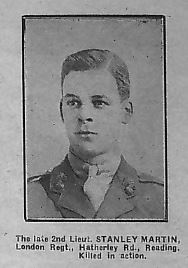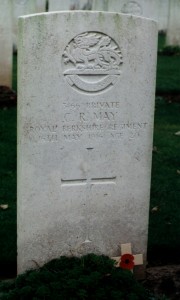George Henry Martin
Sapper 235379
Royal Engineers
Division 49
 |
George Henry Martin lived at 45, Cranbury Road, Reading. His death was notified in the Standard on 27th April 1918. He died on April 3rd 1918, aged 23 years.
He is commemorated on a family grave. His parents were George and Sarah Martin. George’s father was a painter and decorator and George Henry probably worked for him. His occupation as stated in the 1911 census was painters lad. George Henry Martin’s attestation papers are available. He attested on 29 January 1916. Upon enlistment his occupation was given as Crane Driver and driller. He had served 2 years in the 1/4 Royal Berkshire Territorial unit and tried to sign for overseas service in September 1914 but was not considered suitable due to flat feet and a weak right ankle. After attesting he was posted to the Army Reserve the next day and later to Royal Engineers. He served at home from from 21January 1917 until 2 February 1918 where he may have spent sometime working for Inland Waterways. On 2 February 1918 he was discharged as no longer fit for service although it is noted that he would have to attend a further medical examination. George Henry Martin suffered an accident whilst on duty on a barge when woden beams fell on him and severed his spinal cord resulting in paralysis of his lower limbs and requiring constant care.
The author is carrying out further enquiries to establish whether he would be entitled to registration under the CWGC and would be eligible for a war pattern headstone. Sapper Martin is actually buried in the grave currently no information can be found as to his war record through the CWGC Internet site.



